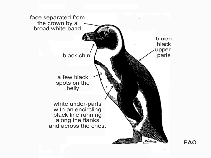Spheniscus demersus (Linnaeus, 1758)
Jackass penguin
Classification / Names Κοινά ονόματα | Συνώνυμα | CoL | ITIS | WoRMS
Aves | Sphenisciformes | Spheniscidae
Environment: milieu / climate zone / εύρος βάθους / distribution range Οικολογία
. Subtropical
Distribution Χώρες | Περιοχές FAO | Οικοσυστήματα | Παρουσίες | Εισαγωγές
Western Indian Ocean and Eastern Atlantic.
Length at first maturity / Μέγεθος / Weight / Age
Γεννητική Ωρίμανση: Lm ? range ? - ? cm Max length : 70.0 cm TL αρσενικό/απροσδιόριστο; (Αναφ. 91362); μεγ. δημοσιευμένο βάρος: 3.1 kg (Αναφ. 356)
Life cycle and mating behavior Γεννητική Ωρίμανση | Αναπαραγωγή | Γεννοβολία | Eggs | Γονιμότητα | Larvae
Main reference
Αναφορές | Συντονιστής | Συνεργάτες
Harrison, P. 1987 Seabirds of the world: a photographic guide. Christopher Helm, Hong Kong, 317p. (Αναφ. 91362)
IUCN Red List Status
(Αναφ. 130435: Version 2025-1)
CITES status (Αναφ. 108899)
CMS (Αναφ. 116361)
Threat to humans
Human uses
| FishSource |
Εργαλεία
Περισσότερες πληροφορίες
Γεννητική Ωρίμανση
Γονιμότητα
Γεννοβολία
Eggs
Egg development
Larvae
Διαδικτυακές πηγές
BHL | BOLD Systems | CISTI | DiscoverLife | FAO(Publication : search) | Fishipedia | GenBank (genome, nucleotide) | GloBI | Gomexsi | Google Books | Google Scholar | Google | PubMed | Δέντρο Ζωής | Wikipedia (Go, αναζήτηση) | Zoological Record



